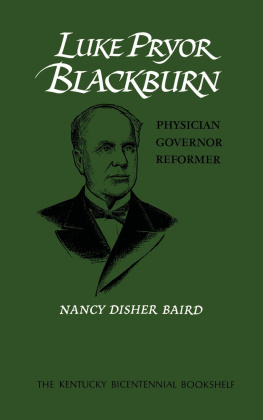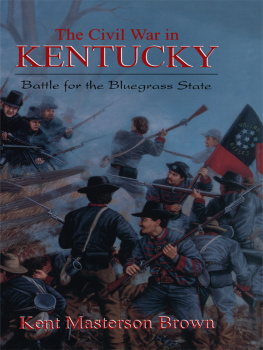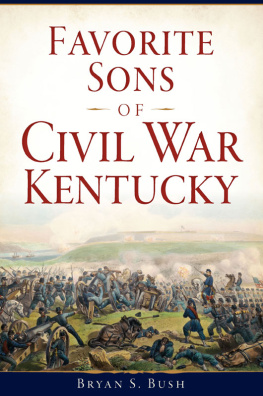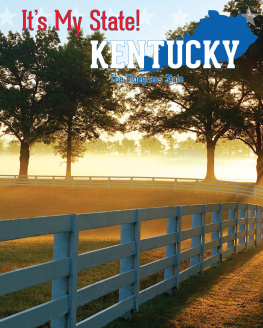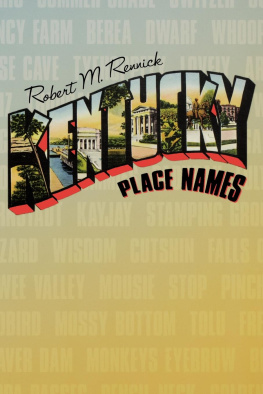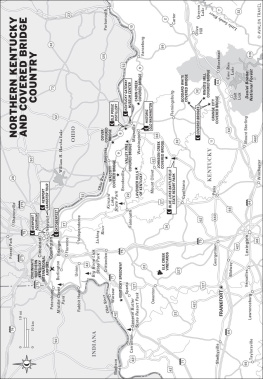NEW BOOKS FOR NEW READERS
Phyllis MacAdam, General Editor
Healing Kentucky
Medicine in the Bluegrass State
Nancy Disher Baird
Publication of this volume was made possible in part by a grant from the National Endowment for the Humanities.
Copyright 2007 by The University Press of Kentucky
Scholarly publisher for the Commonwealth, serving Bellarmine University, Berea College, Centre College of Kentucky, Eastern Kentucky University, The Filson Historical Society, Georgetown College, Kentucky Historical Society, Kentucky State University, Morehead State University, Murray State University, Northern Kentucky University, Transylvania University, University of Kentucky, University of Louisville, and Western Kentucky University.
All rights reserved.
Editorial and Sales Offices: The University Press of Kentucky
663 South Limestone Street, Lexington, Kentucky 40508-4008
www.kentuckypress.com
10 09 08 07 06 5 4 3 2 1
Library of Congress Cataloging-in-Publication Data
Baird, Nancy Disher.
Healing Kentucky : medicine in the Bluegrass State / Nancy Disher Baird.
p. cm. (New books for new readers)
Includes bibliographical references and index.
ISBN-13: 978-0-8131-0914-5 (pbk. : alk. paper)
ISBN-10: 0-8131-0914-0 (pbk. : alk. paper) 1. MedicineKentuckyHistory19th century. 2. MedicineKentuckyHistory20th century. I. Title.
R229.B35 2006
610.9769dc22 2006035403
This book is printed on acid-free recycled paper meeting
the requirements of the American National Standard
for Permanence in Paper for Printed Library Materials.
Manufactured in the United States of America.
| Member of the Association of
American University Presses |
Contents
2. They Died Faster Than Coffins Could Be Made:
The 1833 Cholera Epidemic
4. No One Should Live in Filth:
Yellow Fever and the Kentucky Prison
Foreword
The Kentucky Humanities Council, Inc., began New Books for New Readers because Kentuckys adult literacy students want books that recognize their intelligence and experience while meeting their need for simplicity in writing. The first thirteen titles in the New Books for New Readers series have helped many adult students open a window on the wonderful world of literacy. At the same time, these New Books, with their plain language and compelling stories of Kentuckys history and culture, have found a wider audience among accomplished readers of all ages who recognize a good book when they read one. As we publish this fourteenth book, we thank our authors, our readers, our series editor, and our new reader editors, who together have proved that New Books and the humanities are for everyone.
This volume was made possible in large part by author Nancy D. Baird, a former member of the Board of Directors of the Kentucky Humanities Council, Inc., by her fellow directors, and by alumni directors of the Council as well. We are grateful, also, for the support of many individuals all across the Commonwealth who financially support our mission. We especially thank Dell Hancock, of Paris, who has generously supported our literacy publications.
The Kentucky Humanities Council is grateful for the advice, support, and invaluable partnership provided to us by the University of Kentucky and the University Press of Kentucky, which has expressed an uncommon commitment to the educational interests of the people of Kentucky.
Finally, we express our appreciation for all of our friends who share our belief that homes without books are lives without hope. Thank you for helping us tell Kentuckys story.
Virginia G. Smith, Executive Director
Kentucky Humanities Council, Inc.
TELLING KENTUCKYS STORY
Acknowledgments
Writing a book involves the efforts of many people. I wish to thank series editor Dr. Phyllis MacAdam, whose editorial expertise and suggestions were invaluable. Working with Dr. MacAdam was indeed a joy.
For their evaluations and suggestions on content, form, and vocabulary, my gratitude also goes to Mary Ford and the members of her adult education class at the Bowling Green Technical College: Rosa Andrade, Christine Buchanan, Brandon Hagan, Doris Haley, Samantha Hines, Freddie Holland, Jonathan Metcalf, Tam Nguyen, and Brian Smith. I truly appreciate their help.
This book is dedicated to my favorite medical heroes, Mary, Tom, and Jay, and to my favorite readers, Elizabeth, Mary Nancy, Henry, and Zachary.
Introduction
Kentucky was not a healthy place during the 19th and early 20th centuries. Disease, childbirth, polluted water, bad food, and many other problems killed Kentuckians. In 1850 the average life span was about 40 years. Today, one can hope to live 75 years or more.
Homes and other buildings could be very dangerous. Stoves and fireplaces burned wood and coal to heat buildings and cook food. They also made smoke and soot that polluted the air. Candles and lanterns gave light, but they also increased the threat of fire. Windows had no screens to keep out insects that spread disease.
Drinking water came from wells and streams that were easily polluted. There were no refrigerators to keep foods fresh. Outhouses (outdoor toilets) attracted flies that spread disease. Outhouses also polluted wells and streams.
Doctors were poorly trained. Most of them had not been to medical school. Some had never been to any school! They knew little about the cause, prevention, or cure of disease. Most doctors made their own medicines because there were no drugstores. Laws did not control the safety of pills and tonics. Medicines were often worthless. Many were dangerous.
The first real hospital in Kentucky opened in Louisville in 1823 to care for sick travelers. Most towns did not have hospitals until the mid-20th century. There were few trained nurses. When people got sick, members of the family cared for them.
Today most areas of Kentucky have clean water. Modern lighting and heating systems are cleaner and safer than the old ones. Doctors and nurses are well trained and are licensed by the state. Most towns have drugstores that sell safe medicines. Most towns also have hospitals that provide good medical care.
We know more than our parents or grandparents did about what causes people to get sick. We know how to prevent many illnesses and cure others. Nevertheless, pollution remains a problem and diseases still claim lives. This book tells the story of a 200-year fight to give good health care to all Kentuckians.
1
She Lived!
Early Surgery
Jane Crawford lived on a farm near Greensburg in 1809. Although she thought she was too old to have more children, her stomach began to grow. I think I am going to have a baby, she decided. As her stomach grew, she thought that she might have twins. After nine months no babies were born, yet her stomach continued to grow. She went to a doctor and learned she had a 20-pound tumor growing in her stomach. The doctor in Greensburg did not do surgery, but someone told Jane Crawford about a good doctor in Danville named Ephraim McDowell. He had gone to medical school in Scotland, they told her. He had learned many things other doctors didnt know. Jane wrote to the doctor about her tumor.


